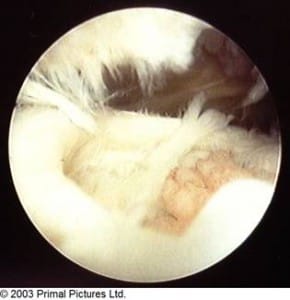ROTATOR CUFF TEARS
Rotator cuff tears can occur as a consequence of either direct trauma or secondary to overuse. Often in the case of overuse, the tendon involved may already exhibit characteristics of a tendinopathy/tendinosis. To complicate matters further, this already weakened tendon may not necessarily be symptomatic prior to the development of a tear.
Rotator cuff tears can be characterised as either partial or complete. Partial tears can vary both in depth and extension of the tendon. They may involve either the underlying surface of the tendon close to the articular surface (>80%) of the humeral head or the bursal surfaces (<20%), i.e. the upper surface of the tendon close to the subacromial bursa. Full thickness tears of the rotator cuff tendons extend through the entire thickness of the tendon, allowing direct communication between the subacromial bursa and the glenohumeral joint.
Rotator cuff tears can occur in any of the rotator cuff muscles, but are generally most common in the supraspinatus and then infraspinatus and subscapularis respectively. Furthermore, these tears are often found in the dominant arm.
See below for scan of a full thickness supraspinatus tear:
In the case of full thickness tears, often surgery is advisable to return the injured shoulder to optimal function.
(The list of conditions given above and subsequent explanations are intended as a general guide and should not be considered a replacement for a full medical examination. Furthermore, we do not purport to treat all the conditions listed. Should you wish to discuss any of these conditions with our chiropractors, please do not hesitate to phone the clinic on 020 7374 2272 or email enquiries@body-motion.co.uk).

